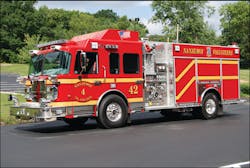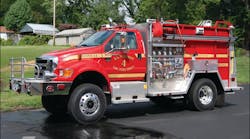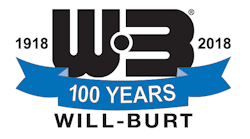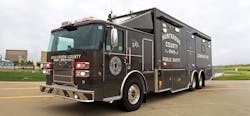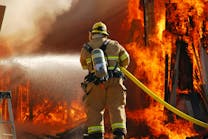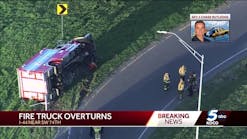In the last installment of Innovative Rigs on the Street we visited the Nanjemoy Fire Department located in Southern Maryland. Under the leadership of Chief Doug Campbell, the Nanjemoy Fire Department operates at Company 4 in Charles County, together with 11 other volunteer fire companies and fourteen rescue squads which protect the area as well as providing automatic aid responses to adjacent counties in Maryland as well as King George County in Virginia.
In addition to the new Brush 44 which was previously featured, the department recently placed into service a 2011 Spartan Gladiator/Rosenbauer pumper as Engine 42. This unit was designed by the department's officers working in close cooperation with Ron Willett from DPC Emergency located in Marydel, Delaware. Due to the rural nature of Nanjemoy's first due area it was important for the new pumper to have a large water carrying capacity in addition to carrying a full complement of engine company equipment. The result was a new engine equipped with a Hale Q-max 1500 gpm pump together with a 1,500-gallon water tank built with an overall length of 32 feet 5 inches. The overall height of the unit is 10 feet 3 inches with the high point being the light tower shield on top of the cab roof.
The Spartan Gladiator four-door cab is built on a wheelbase of 191 inches and is powered by a Caterpillar C-13 engine rated at 525 horsepower with an Allison EVS-4000 automatic transmission. The apparatus is equipped with a Meritor MFS front axle rated at 21,500 pounds and a RS-30-185 rear axle rated at 31,500 pounds. Braking is provided by 17-inch disc brakes on the front with 16 1/2-inch by 7-inch S-cam brakes on the rear axle. Auxiliary braking is provided by a Caterpillar engine brake with a second gear pre-select when the engine brake is engaged.
Cab & Chassis
The cab is provided with a 10-inch raised roof with seating for six personnel including five seats equipped with self-contained breathing apparatus. The medium length four-door cab was chosen to keep the wheelbase down to a minimum while providing adequate room inside of the cab for personnel, portable radios and handlight equipment.
The chassis' electrical system is powered with six Group 31 batteries together with a 320-amp rated alternator. The front bumper was extended 24 inches to provide space for mounting a front suction, trash line and center mounted electric cable reel. Hose wells are installed to hold 20 feet of 5-inch suction hose and 150 feet of 1 3/4-inch attack line. Air horns, fog lights and an electronic siren speaker are recess mounted in the front bumper together with a mechanical siren mounted on the top deck.
Pump & Body Features
The 1,500 gpm fire pump is provided with an air operated front suction and a Hale MIV electric control for the left side 6-inch suction inlet. Discharges include two 2 1/2-inch discharges on the left side and one 2 1/2-inch discharge on the right side pump panel. A front bumper 2-inch trash line together with twin 2-inch crosslay discharges are provided with additional 2-inch and 2 1/2-inch discharges located in the hose bed area. A right side 3-inch LDH discharge is provided with an Akron electric valve. The area over the fire pump is equipped with a small hose reel carrying 200 feet of 1-inch hose and an Akron model 3423 electric monitor. An on-board foam system is equipped with a 20-gallon foam tank which supplies the front bumper trash line.
The apparatus body is fabricated from aluminum and measures 160 inches long and is provided with seven enclosed body compartments with job color roll up shutter doors. The 100-inch wide body provides for a useable depth of 26 inches in the lower portion of the side body compartments. The hose bed is protected by aluminum tread plate lift up covers with a unique tread plate rear panel for each side. The underside on one of the covers is equipped with a pocket to hold backboards. Hard suction hose storage is provided at the rear of the body inside of enclosed compartments under the water tank on each side. Ground ladders, carried on the right-side body ladder rack, include a 10-foot folding, 14-foot roof and 24-foot extension ladder
Emergency warning lighting includes a Whelen Freedom FN72QLED forward facing light bar with Whelen 45B20 LED side facing warning lights on each side of the cab. Forward facing lighting consists of twin pedestal Mars lights, roto-ray and twin Whelen LED lights. The side of the cab and body are equipped with Whelen 600 LED warning lights with Whelen LED beacons and alternating flashing lights at the rear of the body.
A Harrison 10-Kw hydraulic generator supplies power to two Hannay electric cable reels, two forward facing Fire Research Focus cab brow lights together with Fire Research telescopic lights at the rear of the cab. Whelen scene lighting is provided on each side of the cab and body including the rear. A Wilburt Night Scan light tower is mounted on top of the cab roof and is protected by an aluminum painted shroud across the front and each side.
Engine apparatus that are equipped with water tanks larger than 1,000 gallons typically are built on long wheelbase chassis with overall lengths approaching 34 feet. The problem with these vehicles are that they typically will be one of the longest and heaviest units in the departments fleet and do not provide the same level of maneuverability with respect to turning radius during fireground operations. A lot of fire trucks are simply too large to be practical for everyday operations. The Nanjemoy Fire Department did a great job in designing a practical size engine apparatus to meet the needs of their first due area.
Appreciation is given to Mr. Jeff Hawkins of DPC Emergency Equipment who provided technical information for use in this article.
TOM SHAND is a 37-year veteran of the fire service having served with departments in Maryland, Pennsylvania and New York. He has worked in the fire apparatus industry since 1985, including 15 years with Saulsbury Fire Apparatus. He is a contributing editor to Fire Apparatus Journal and Firehouse Magazine and works with Mike Wilbur at Emergency Vehicle Response. He co-hosts the Apparatus Architects podcast with Wilbur, based on their column in Firehouse Magazine.
